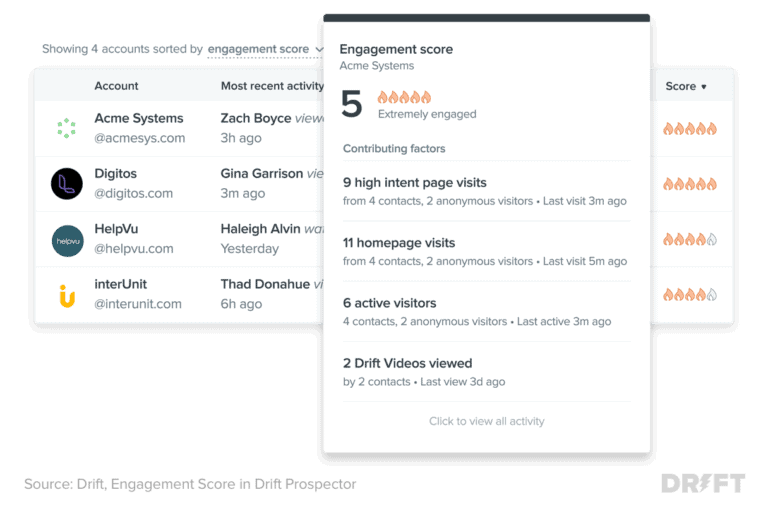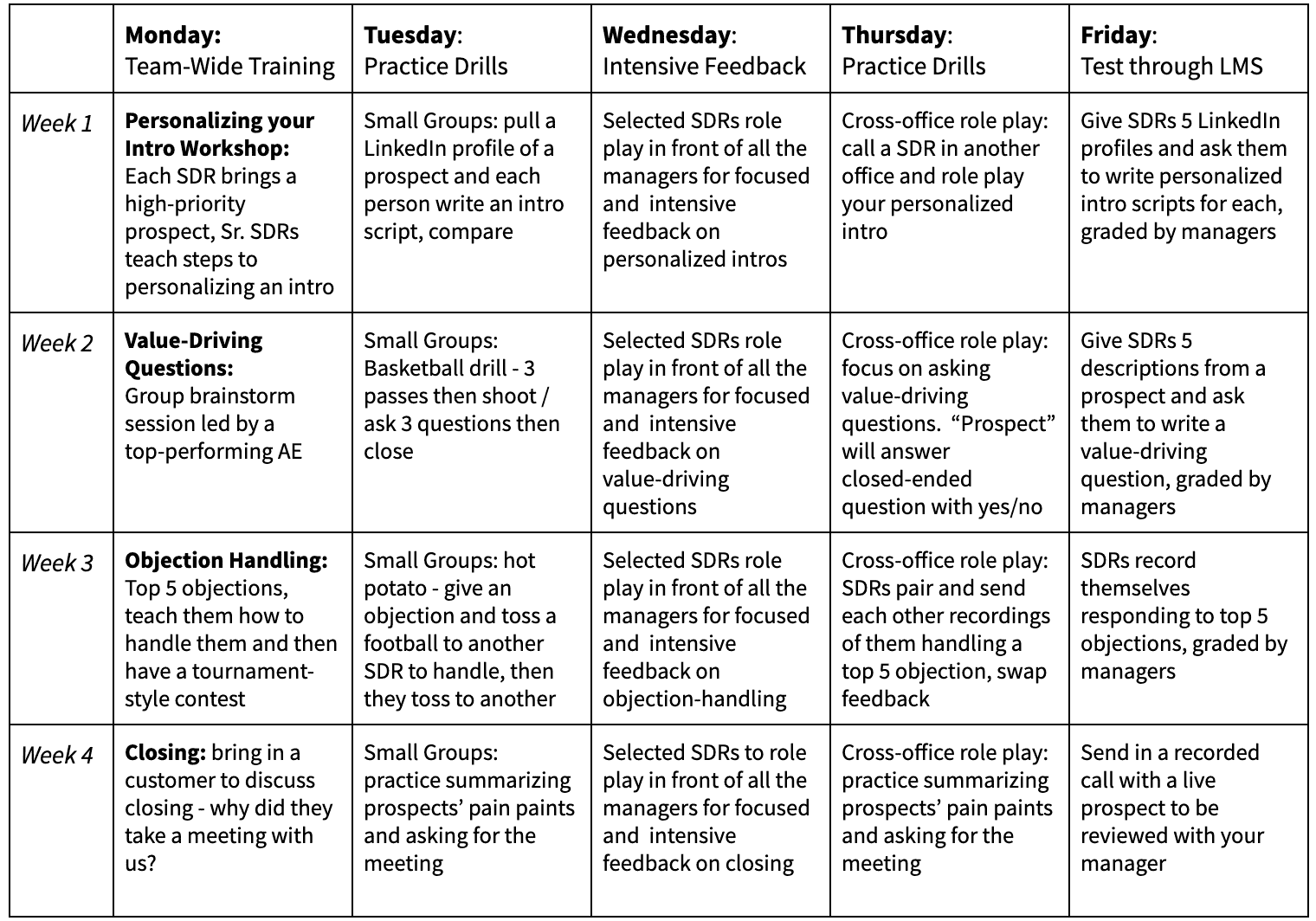As the Director of Sales Development at Drift, no two days are the same. I’m constantly adapting, solving problems, meetings with reps, forecasting, and planning. The pandemic and Drift’s transition to being a Digital First company have made my days even more interesting.
The thing is, since March 2020, we’ve all had to change the way we work. And while the shift to a customer-first sales mentality has been happening for a few years, it’s more clear than ever which companies have made the change to Conversational Marketing & Sales – and who hasn’t.
Conversational selling is ingrained into every single one of our SDRs at Drift. It’s how we make our SDRs better sellers in the future. But most importantly, we train our SDRs in Conversation Sales because we want to treat buyers like people, not leads. That means we have to meet our buyers where they are and personalize the buying experience to their needs (not our own).
So while “a day in my life” is always changing, I figured I could at least show you how I structure my day to enable my team and make sure they keep a customer-first mindset.
The Morning
I start every day with a team stand-up. Managers and SDRs come together and review meeting counts and opportunities. Each SDR will give a quick update on where they are for the month and share and celebrate their wins.
These huddles are SDR-led, which gives them a professional development opportunity for facilitating a meeting. We rotate all of our SDRs in running this huddle and when it’s their turn, they also bring an insight to the team in a segment we call “what’s working for me.” This is a collaborative way to get their juices flowing before they start prospecting.
While daily visibility into a leaderboard is great for inspiring friendly competition, it’s a frustrating feeling for an SDR coming into that meeting if they’re having a slower month and aren’t hitting their number. As a manager, I want to understand their pain points and help them come up with fresh tactics for their outreach. After our stand-up, it’s typical I’ll have a 1:1 or metric review with a new or struggling rep.
During a metric review, we will go over the entire SDR funnel – contacts sequenced, calls, chats, meetings booked, meetings held, opportunities generated, and all the conversions in between.
Then it’s time for 1:1s. I encourage the SDR to set the agenda. Sometimes they will select calls, emails, or chats for a coaching session or they’ll highlight a part of their workflow that they want to make more efficient. I think of the 1:1s as more of a coaching mechanism to solve problems we’ve identified during the metric reviews
In my 1:1’s I often hear something like, “Hey, I am awesome at writing emails, but I’m not going to pick up the phone.”
Or another SDR might say, “I’m really good on the phone. I just want to make phone calls.”
But what if one of your highest priority target accounts doesn’t prefer your favorite engagement channel? If an SDR’s prospect isn’t going to pick up the phone, then they’ve got to be able to engage in other channels as well.
That’s where the importance of a multichannel approach comes in. It’s not just a buzzword. It’s about meeting the buyer where they’re at. If you rely on one channel, you might only be booking 20% to 30% of your potential meeting – and no SDR manager wants that.
I’ll also make sure that the SDR is prioritizing accounts by looking at intent-based signals, industry, company size, and other factors. Our SDRs do this using Drift Prospector.
Drift Prospector relies on AI and all of your data sources to deliver recommendations on how to prioritize accounts and who to contact. This is super important because SDRs are typically earlier in their career and don’t stay in the role long, they can’t rely on industry experience to choose which accounts to prioritize. They need a little help from AI.

The Early Afternoon
In the early afternoon, I’ll meet back with my SDR team for our weekly chat analysis. In that meeting, we have inbound reps and outbound reps bring up conversations that they’ve had with prospects in Drift chat.
We use a group setting for this meeting so each SDR can receive feedback from their peers and managers. They also get to learn from their peers and understand what tactics are working and not working.
We hold these meetings for two reasons. The first is to make sure we’re keeping the customer at the center of everything we do. The second reason we meet in these group settings is to foster a learning environment, which is particularly important in a remote setting.
There are a few other types of training sessions we do throughout the week. On Mondays, we do a team-wide training and have a subject matter expert instruct, whether it be a senior SDR, SDR leader, other Drifters in different departments, or even customers.
On Tuesdays and Thursdays, we run practice drills so they have an opportunity to implement the new skill in a controlled environment. On Wednesdays, we select a small group (usually of new or struggling SDRs), to participate in an intensive feedback session on that particular skill. On Fridays, we do activities to measure knowledge retention.
Here’s a breakdown of what that monthly training schedule looks like:

The Late Afternoon
As the late afternoon rolls around, I’ll take some time to block my calendar for heads-down work like answering emails, starting a project, creating reports, or answering slack questions from people on other teams.
Collaborating with people outside of just my team is a really important part of my routine. I’m talking daily with marketing, sales operations, and sales leadership.
Having alignment with marketing is key to my team’s success. I’m always in lockstep with our marketing partners sharing feedback with them on the sentiment of different lead sources and help plan for upcoming campaigns.
Other topics we look at weekly are conversion numbers, SLAs, team changes (and how that may affect lead routing), and pipeline forecasting.
I always plan pipeline forecasting a quarter in advance. To do this, I work closely with sales operations. Communication with my sales ops teammates is an integral part of my routine. Aside from pipeline forecasting, I work closely with them on SDR/AE alignment and account coverage. I don’t know what I would do without them.
All of this data pulled in collaboration with the marketing and ops teams gets shared with sales leadership. In the late afternoon, I may have a meeting with leadership to share data and insights from the SDR org and look at what’s working, what’s not working, review meeting quality, SDR/AE alignment, and of course, pipeline forecasting.
This would not be possible without SDR managers. My daily routine often includes a 1:1 with an SDR manager or coaching to make sure there is alignment across the SDR org.
One report that we will often look at together is SDR performance.
When I measure an SDR team, I look for both leading and lagging indicators. Lagging indicators you can think of as your output or your results. Leading indicators you can think of as your input or your effort. Lagging indicators typically come in the form of opportunities. That’s how SDR teams are typically measured – on sales-qualified opportunities (SQOs).
There are a ton of inputs that go into making sure you’re put in a position to be successful as an SDR. It’s really easy to look back at the end of the month and think, “you hit all of your numbers, reached your opportunity quota, congratulations!”
A great manager will actually take those leading indicators and make sure that we’re looking at the right numbers going into the month. That’s why leading indicators are so important for me. Those include things like conversations with prospects, outbound calls made, contacts added to sequences, and activity.
With Drift, you can get really granular with those input metrics. Three metrics we use to measure with Drift are conversations with prospects in our platform, meetings scheduled in our platform, and most importantly, the conversion between the two.
Most companies will shoot for a 2% conversion rate on their website traffic.
We hold our SDR teams to a 5% conversion rate on their website traffic, and we’re able to reach that because Drift allows you to engage with prospects when the time is right, when they’re active on the website, and when they’re at their highest intent ⚡
Signing Off
So, yes, my days really are never the same. But they will always include coaching, ongoing training, finding the right metrics, encouraging our SDRs, and coming together as a team to learn.
At the end of the day, I’m coaching our next generation of sellers. That’s what matters most.









